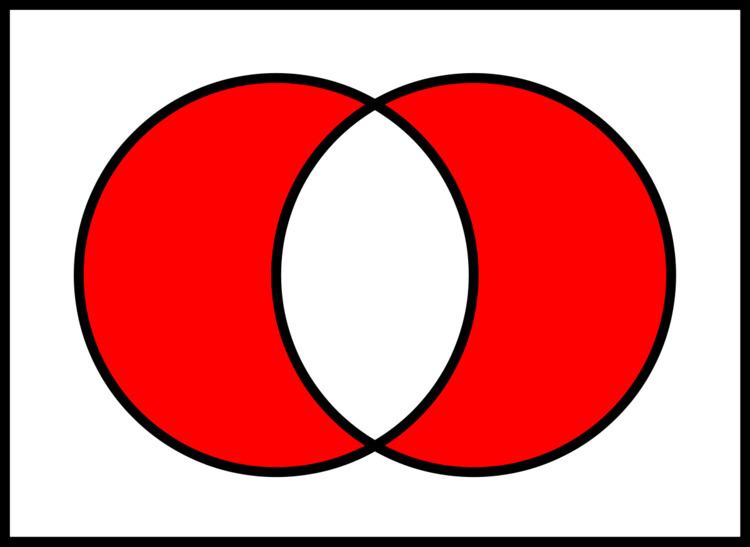 | ||
In mathematics, the symmetric difference, also known as the disjunctive union, of two sets is the set of elements which are in either of the sets and not in their intersection. The symmetric difference of the sets A and B is commonly denoted by
Contents
- Properties
- n ary symmetric difference
- Symmetric difference on measure spaces
- Hausdorff distance vs Symmetric difference
- References
or
or
For example, the symmetric difference of the sets
The power set of any set becomes an abelian group under the operation of symmetric difference, with the empty set as the neutral element of the group and every element in this group being its own inverse. The power set of any set becomes a Boolean ring with symmetric difference as the addition of the ring and intersection as the multiplication of the ring.
Properties
The symmetric difference is equivalent to the union of both relative complements, that is:
The symmetric difference can also be expressed using the XOR operation ⊕ on the predicates describing the two sets in set-builder notation:
The same fact can be stated as the indicator function (which we denote here by
The symmetric difference can also be expressed as the union of the two sets, minus their intersection:
In particular,
The symmetric difference is commutative and associative (and consequently the leftmost set of parentheses in the previous expression were thus redundant):
The empty set is neutral, and every set is its own inverse:
Taken together, we see that the power set of any set X becomes an abelian group if we use the symmetric difference as operation. (More generally, any field of sets forms a group with the symmetric difference as operation.) A group in which every element is its own inverse (or, equivalently, in which every element has order 2) is sometimes called a Boolean group; the symmetric difference provides a prototypical example of such groups. Sometimes the Boolean group is actually defined as the symmetric difference operation on a set. In the case where X has only two elements, the group thus obtained is the Klein four-group.
Equivalently, a Boolean group is an Elementary abelian 2-group. Consequently, the group induced by the symmetric difference is in fact a vector space over the field with 2 elements Z2. If X is finite, then the singletons form a basis of this vector space, and its dimension is therefore equal to the number of elements of X. This construction is used in graph theory, to define the cycle space of a graph.
From the property of the inverses in a Boolean group, it follows that the symmetric difference of two repeated symmetric differences is equivalent to the repeated symmetric difference of the join of the two multisets, where for each double set both can be removed. In particular:
This implies triangle inequality: the symmetric difference of A and C is contained in the union of the symmetric difference of A and B and that of B and C. (But note that for the diameter of the symmetric difference the triangle inequality does not hold.)
Intersection distributes over symmetric difference:
and this shows that the power set of X becomes a ring with symmetric difference as addition and intersection as multiplication. This is the prototypical example of a Boolean ring. Further properties of the symmetric difference:
The symmetric difference can be defined in any Boolean algebra, by writing
This operation has the same properties as the symmetric difference of sets.
n-ary symmetric difference
The repeated symmetric difference is in a sense equivalent to an operation on a multiset of sets giving the set of elements which are in an odd number of sets.
As above, the symmetric difference of a collection of sets contains just elements which are in an odd number of the sets in the collection:
Evidently, this is well-defined only when each element of the union
Suppose
Symmetric difference on measure spaces
As long as there is a notion of "how big" a set is, the symmetric difference between two sets can be considered a measure of how "far apart" they are. First consider a finite set S and the counting measure on subsets given by their size. Now consider two subsets of S and set their distance apart as the size of their symmetric difference. This distance is in fact a metric so that the power set on S is a metric space. If S has n elements, then the distance from the empty set to S is n, and this is the maximum distance for any pair of subsets.
Using the ideas of measure theory, the separation of measurable sets can be defined to be the measure of their symmetric difference. If μ is a σ-finite measure defined on a σ-algebra Σ, the function
is a pseudometric on Σ. dμ becomes a metric if Σ is considered modulo the equivalence relation X ~ Y if and only if
If
Let
Symmetric difference is measurable:
We write
We write
We write
The "symmetric closure" of
Hausdorff distance vs. Symmetric difference
The Hausdorff distance and the (area of the) symmetric difference are both pseudo-metrics on the set of measurable geometric shapes. However, they behave quite differently. The figure at the right shows two sequences of shapes, "Red" and "Red ∪ Green". When the Hausdorff distance between them becomes smaller, the area of the symmetric difference between them becomes larger, and vice versa. By continuing these sequences in both directions, it is possible to get two sequences such that the Hausdorff distance between them converges to 0 and the symmetric distance between them diverges, or vice versa.
